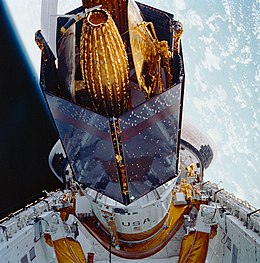 | |
| Names | Space Transportation System-26 STS-26R |
|---|---|
| Mission type | Return to Flight and TDRS-C deployment |
| Operator | NASA |
| COSPAR ID | 1988-091A |
| SATCAT no. | 19547 |
| Mission duration | 4 days, 1 hour, 11 seconds |
| Distance travelled | 2,703,000 km (1,680,000 mi) |
| Orbits completed | 64 |
| Spacecraft properties | |
| Spacecraft | Space Shuttle Discovery |
| Launch mass | 115,487 kg (254,605 lb) |
| Landing mass | 88,078 kg (194,179 lb) |
| Payload mass | 21,082 kg (46,478 lb) |
| Crew | |
| Crew size | 5 |
| Members | |
| Start of mission | |
| Launch date | September 29, 1988, 15:37:00 UTC (11:37 am EDT) |
| Launch site | Kennedy, LC-39B |
| Contractor | Rockwell International |
| End of mission | |
| Landing date | October 3, 1988, 16:37:11 UTC (9:37:11 am PDT) |
| Landing site | Edwards, Runway 17 |
| Orbital parameters | |
| Reference system | Geocentric orbit |
| Regime | Low Earth orbit |
| Perigee altitude | 301 km (187 mi) |
| Apogee altitude | 306 km (190 mi) |
| Inclination | 28.45° |
| Period | 90.60 minutes |
| Instruments | |
| |
 STS-26 mission patch  Back row: Lounge, Hilmers and Nelson Front row: Covey and Hauck | |
STS-26 was the 26th NASA Space Shuttle mission and the seventh flight of the orbiter Discovery. The mission launched from Kennedy Space Center, Florida, on September 29, 1988, and landed four days later on October 3, 1988. STS-26 was declared the "Return to Flight" mission, being the first mission after the Space Shuttle Challenger disaster of January 28, 1986. It was the first mission since STS-9 to use the original Space Transportation System (STS) numbering system, the first to have all its crew members wear pressure suits for launch and landing since STS-4, and the first mission with bailout capacity since STS-4. STS-26 was also the first U.S. space mission with an all-veteran crew since Apollo 11, with all of its crew members having flown at least one prior mission.
The mission is technically designated STS-26R, as the original STS-26 designation previously belonged to STS-51-F (also known as Spacelab-2). Likewise all flights with the STS-26 through STS-33 designations would require the R in their documentation to avoid conflicts in tracking data between the old and new flight designations.[1]
- ^ Jenkins, Dennis R. (2016). "Chapter 18 - Destiny Fulfilled - The Intended Purpose". Space Shuttle: Developing an Icon - 1972-2013. Vol. III: The Flight Campaign. Forest Lake, Minnesota: Specialty Press. p. 130. ISBN 978-1580072496.